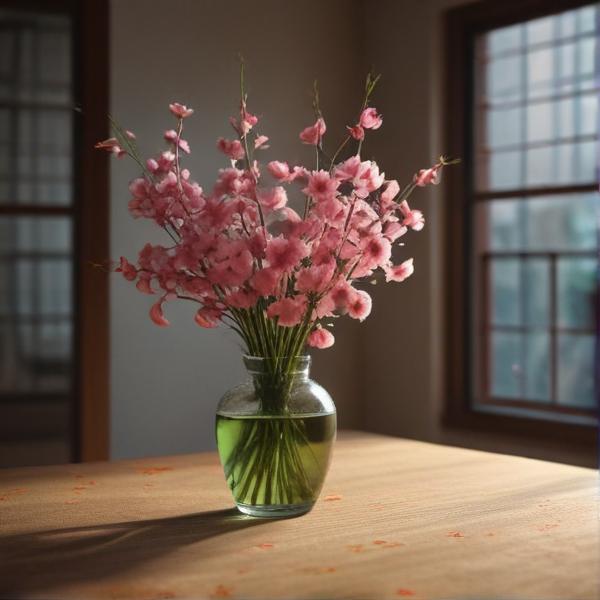基本信息 (Basic Information)
含义与用法 (Meanings & Usage)
中文核心释义 (Core Chinese Meaning): 植物的花朵,也可引申为美丽的事物或色彩鲜艳的东西。
英文核心释义 (Core English Meaning): flower; blossom; also refers to something beautiful or colorful.
象形意义 / 为何这么写 (Pictographic Meaning / Writing Rationale)
文言文释义 (Classical Chinese Meaning)
与现代意义相近,主要指植物的花朵,也可指事物的末端或事物之美。Similar to modern meaning; mainly refers to the blossom of plants, and can also mean the tip of something or its beautiful aspect.
深入学习 (In-depth Study)
字源故事 (Origin Story)
字形演变 (Character Evolution)
常用词语和例句 (Common Words & Examples)
花朵 (flower; blossom)
花园里开满了五颜六色的花朵。
Eng: The garden is full of colorful flowers.
花钱 (to spend money)
买书是很值得花钱的事情。
Eng: Buying books is something worth spending money on.
花布 (calico; patterned cloth)
她穿着一条漂亮的花布裙子。
Eng: She is wearing a beautiful patterned skirt.
相关成语 (Related Idioms)
百花齐放
Meaning: A hundred flowers bloom; denotes diversity and flourishing of many talents or ideas.
多语言翻译 (核心释义) (Translations (Core Meaning))
- French: fleur
- German: Blume
- Spanish: flor
- Italian: fiore
- Portuguese: flor
- Russian: цветок
- Arabic: زهرة
- Persian: گل
- Dutch: bloem
- Polish: kwiat
- Vietnamese: hoa
- Ukrainian: квітка
视频学习资源 (Video Learning Resources)
通过以下链接在热门视频网站搜索 "花" 的更多讲解:
Search for more explanations of "花" on popular video sites:
- 在 Bilibili.com 搜索 "花 字源 说文解字" (Search on Bilibili)
- 在 YouTube.com 搜索 "hua 花 character origin etymology" (Search on YouTube)
网络参考 (Web References for "花") ()
网络内容摘要 (Web Content Summary):
```html“花”字核心含义与象形起源:“花”原为“华”的异体,最早见于西周金文。其字形源自象形,表现一棵树上盛开的花朵,花瓣绽放、花枝弯曲,生动描绘了花卉的形象。 Core Meaning & Etymology: The character "花" (huā, flower) originates as a variant of "華", first appearing in Western Zhou bronze inscriptions. Its form is pictographic, depicting blossoming flowers with spreading petals and curved branches.
有趣的文化背景:古人常用花枝装饰乐器,表达庆祝、喜悦之意。在字形演变中,“花”也象征繁荣和美好。 Cultural Note: In ancient times, flower branches were used to decorate musical instruments for celebrations. "花" thus conveys prosperity and beauty in Chinese culture.
- 常见用法:“花”可指植物的花朵,也指装饰、支出(如“花钱”)、花样等。 Common Usage: "花" primarily means flower, but can also mean to decorate, to spend (e.g., "花钱" spend money), or pattern/variety.
- 易混淆点:“花”与“华”(huá,意为华丽、中华)容易混淆,注意语境与发音区别。 Easily Confused: "花" (huā, flower) and "华" (huá, splendid/Chinese) look similar but differ in meaning and pronunciation.
- 常用词语/成语:如“花朵” (flower), “花园” (garden), “花费” (expense/spend)。常见成语有“百花齐放” (a hundred flowers bloom,形容多种事物繁荣发展)。 Common Words/Idioms: E.g., "花朵" (flower), "花园" (garden), "花费" (expense/spend). Idiom: "百花齐放" ("a hundred flowers bloom," refers to the prosperous development of many things).
提醒:目前关于“花”的起源与演变的详尽资料有限,更多有价值的内容可参考相关汉字学资料。 Note: Detailed information on the origin and evolution of "花" is limited; for further research, consult specialized works on Chinese character etymology.
```汉字"花"的起源、演变过程-汉字字源辞典
"花 " 是 " 華 " 的异体字。 華 ,甲骨文 是象形字,字形像一棵树 上满是花枝 的样子。 金文 将甲骨文字形中的"木" 写成 ,同时加"于" (竽,乐器),表示古人用花枝装饰欢庆的乐器。 籀文 像枝叶茂盛的植物 有许多灿烂的亮点 闪烁其间。 篆文 将金文字形中的 写成 ,将金文字形中的 ...
花:汉字的起源与演变(小学一年级语文生字 第32集) - 知乎
一、字形演变"花"本作"华",华是古花字,最早见于西周金文。字形就像一朵绽放的花朵。上方是花瓣、向两侧下垂,下面是弯曲的花枝。 小篆延续金文字形,写法与金文基本一致,有的加了草字头"艸(艹)",写作…
更多图片 (花 More Images) ()
